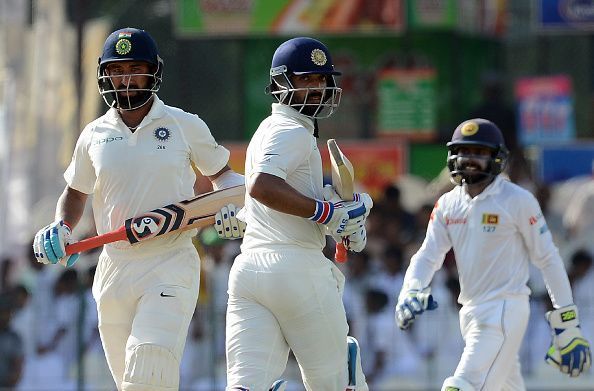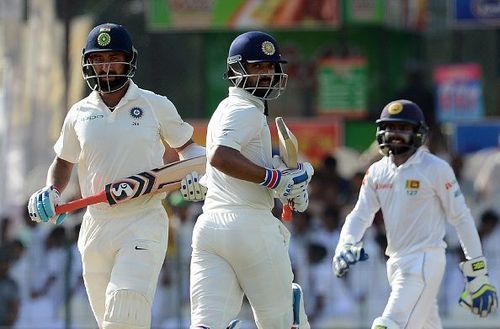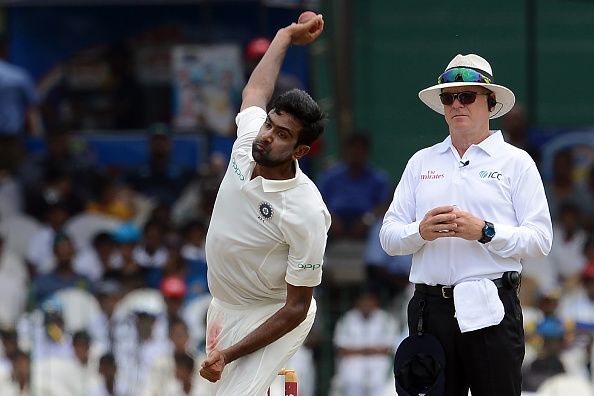
The Pujara-Rahane partnership turned the Colombo Test

The batsmen make a good bunch of cricketers for India, and given the bench strength that India have, these 600+ scores really don't come as a surprise. Rohit Sharma, one of the better batsmen in the squad has had to sit out because there simply isn't a spot for him. Murali Vijay, who has been rated as one of the more stable opening batsmen, got injured and Shikhar Dhawan replaced him in the squad. Another first-choice opener KL Rahul got ill, and Abhinav Mukund replaced him. Both Dhawan and Mukund got runs in Galle.
In Colombo, when Rahul returned Mukund had to miss out but Rahul made sure that he didn't miss out on scoring. So you can see that there's a lot of competition for the places in the side. One reason behind this competition is the level cricket that is being played at the 'A' level and the U-19 level.
Youngsters coming up through the ranks -- Karun Nair is a prime example, who scored a triple hundred against England -- are also being asked to wait at the doors. That's the amount of competition that India have for the spots.
While you could say that a majority of Tests played by India over the past two years were at home or in the subcontinent where the conditions are familiar, the way the team battled it out to win eight Test series on the trot is nothing short of exceptional.
Credit must be given to the batsmen, all of whom have been among the runs this series. Cheteshwara Pujara has been scoring centuries for fun, Shikhar Dhawan and Virat Kohli scored hundreds in Galle and Ajinkya Rahane scored one in Colombo.
Sri Lanka did the best that they could
This is the change that T20 cricket has ushered in. You can now see 400 runs being scored in a day, 600 in an innings, and despite getting these many, teams are left with enough time to bowl the opposition out. A healthy scoring rate augurs well for Test cricket because the matches become result-oriented. India have been scoring quickly of late and that has left them with time to bowl the opposition out after declaring at a big score.
When runs are scored quickly the spectators or the followers of the game, especially in the era of T20 cricket, are hooked to Test matches as they are treated to shots as well as wickets -- remember teams play high-risk cricket when playing aggressively.
There's an argument being floated that the draws have disappeared from Test cricket. However, I think that the more is the number of results in Test cricket, the better it is for the game. In situations like the one we had in Colombo where you had to bat out a session and a day to save the Test, and winning the game was arguably out of question, the batsmen could adopt a strategy to play positively.
If you concede a lead of 440 in the first innings and then play defensively while following-on, you're giving the opposition the chance to dominate you. The bowlers start hitting their spots consistently making things extremely difficult for the batsmen.
On the other hand, if you attack, just like Kusal Mendis did in the second innings, you get the score Sri Lanka got in their second innings. Had they been defensive in their second essay they would not have been able to score close to 400 runs.
When there's time to bat out apart from the runs, a defensive mindset rarely works. In this case, there were more than two days and Sri Lanka managed to cover half the distance, which is commendable. Had there not been much time left in the game, maybe the Lankans could have played defensively.
A case in point here was the Delhi Test of 2015 where South Africa almost blocked their way out of the Test match but they had only a day and a session to bat, which while still being too much for modern-day teams was not the case in Colombo. Blocking for two and a half days is tough, and therefore, what Sri Lanka did was the best that they could have managed.
When you attack the way Mendis and Karunaratne did -- Mendis brought up his hundred off just 120 balls-- you make the opposition bowlers think. They'll have to then vary their pace, lines, and lengths and try to do different things to get you out. Even more so on a surface where the ball was gripping and turning.
Hence, the attacking brand of cricket that Sri Lanka played did not only augur well for them but also gave a message to other teams as to how to bat in the sub continent even after a first-innings deficit and following-on.

India are in a good state now
The partnership between Cheteshwar Pujara and Ajinkya Rahane set the tone for the Test. They laid the platform on which the lower middle-order could capitalize -- tailenders no more, any of them, be it Ravichandran Ashwin or Ravindra Jadeja.
The contributions of Wriddhiman Saha and Hardik Pandya cannot be ignored either, but what made all of these men bat the way they did was the partnership between Pujara and Rahane. Ashwin and Jadeja picked up five-wicket hauls with the ball as well but they had a 600-run cushion using which they could bowl freely.
Following on is a never good thing for any team. But in Colombo, Sri Lanka had nothing to lose. And you can be dangerous, if you have nothing to lose. Sri Lanka played like they had nothing to lose. They knew that they might go down in the process, which they did, but for the first time in the series, they showed a semblance of resolve, an intent to fight.
They kept sweeping the Indian spinners, which isn't easy, especially on a day four track where the ball is turning. You sweep the good-length balls and force the bowler to alter his length. And the bowler bowls too short or too full, you can play your drives or pulls. That's what Sri Lanka tried to do and were successful to some extent.
Winning eight successive Test series -- be it at home or away from home -- is a tremendous achievement. Out of those eight, three were away series -- two in Sri Lanka and one in the West Indies -- and all eight of them were dominating victories.
Even against Australia in February, India bounced back from a 0-1 deficit to win the series 2-1. England had won in India in 2012, but they weren't given a sniff this time. Hence, the achievements of this team have been tremendous and credits must be given where due.
Yes, you could say that the tours to South Africa, England, New Zealand and Australia would pose different challenges, but the team has the capability to do well. India have an aggressive captain, and the team is ready to back the captain's aggressive.
The thinking behind team selection has also been healthy with just rewards for whoever does well. For instance, Rahane was brought back in the playing eleven even as Karun Nair had scored a record-breaking triple-hundred in Chennai. Likewise, KL Rahul regained his place in the side after missing the first Test in Galle and Abhinav Mukund, who had scored a fifty in that Test, had to make way.
This gives the players a sense of security in that their good performances in the past are not forgotten and the runs made do not go in vain. So India are in a very good state at the moment. All the batsmen are getting runs, and even when one of them fails, the others step up. To back it all, the bowlers are picking up 20 wickets.